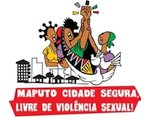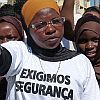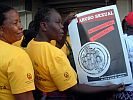Policies and strategies for gender equality: constraints and ambiguities
Ana Loforte
Introduction
Development is essentially a process of allocating and utilizing resources for the social and economic benefit of society. Unfortunately, the result of this process in many countries (and Mozambique is no exception) is the promotion of certain groups and the marginalisation, exclusion and subordination of others. As a social group, women are systematically excluded from political and economic participation and from the benefits resulting from development. Women are the last to benefit from growth because of their subordinate economic and social position: the result of a continual lack of opportunities in education, training and employment and limited access to health and other social services.
Since the mid 1990s the Mozambican Government has made efforts to reverse this situation. The Government has attempted to comply with the recommendations of CEDAW (1993), the Beijing Action Platform (1995) and the SADC Declaration of Gender and Development (1997) by introducing gender issues in its development plans and policies. By doing this it aims to eliminate the factors limiting women’s access to and control of resources and decision-making bodies.
In this document we aim to present some of the challenges that various sectors, such as the health sector, are confronting in their attempts to implement the Government’s strategic objectives for reducing gender inequalities. The development of new approaches to planning and management and the need to formulate transformative gender policies (Kabeer: 1996) require the kind of technical ability and competence that are still unavailable at every level within the sectors.
The information in this document is based on an analysis of reports and working documents prepared by consultants in assessing the degree to which measures aiming to achieve gender equality in the Ministries have been implemented.
1. The conceptual framework of the analysis
The Beijing Action Platform adopted in 1995 drew attention to the concept of gender mainstreaming1. Gender mainstreaming attempts to attain gender equality in development activities by putting an end to the concept of women as a separate, vulnerable target group. In this way, governments and other actors in the social sphere should promote policies and actions that integrate gender issues into every programme and plan, applying an integrated philosophy to institutionalise gender.2
The term gender becomes part of a referential framework to be applied in the institutions and those that they interact with. The term thus becomes the ideal vehicle for raising the profile of practices of social intervention involving men and women, emphasising the relational character of the concept.
There is now far more discussion about the fundamental character of the democratisation of gender relationships as a process that aims to attain developmental goals, which are not simply of an economic nature. This broadening of the conceptual framework has prioritised the quality of social relationships experienced by the beneficiaries of development over their material and economic gains. The change has strongly favoured policies that are less focused on specific social groups but more concerned with fundamental aspects that result in social development as a whole in a particular region. Gender relations are viewed as one of these fundamental aspects.
In as far as organisations with differing aims and affiliations identify with the concept of gender, it is necessary to construct a common language with markers that draw attention to the central place of the term’s transversality. In other words, gender should be seen as fundamental for the success of the programmes and projects of any institution that is committed to development and citizenship.
It is true that the transversal status of gender has contributed towards creating specialists capable of disseminating the significance of gender and translating this into concrete instruments of planning and social action. Despite the availability of people with the appropriate abilities and credentials for disseminating gender issues, and although governments have committed themselves to a significant political undertaking by ratifying international agreements, experience has shown that such actions have not resulted in great advances in gender integration. Progress is limited and, using Blachden’s terminology3, an evaporation policy is in evidence whereby excellent ideas and analyses related to gender tend to be forgotten when strategies are being formulated and programmes implemented. We believe that the absence of a commitment to transform certain social scenarios is one of the factors responsible for this situation. A realistic level of transformation needs to be established and as well as an attainable future scenario to work towards.
In this context it is essential that the institutions begin by questioning structural factors that subordinate women (that is, the inequalities of power and gender that society conforms to) and find concrete methods of confronting them. As Stolcke (2002:404) maintains, ‘in a globalized world, dominated by a neo-liberal paradigm which constantly breaks its promises to bring about greater well-being for a greater number of human beings, the celebration of difference implies the danger of masking growing inequalities and the reasons for these and also encourages new fractures and conflicts. This means that the power relationships that actually bring about social and gender exclusion and discrimination are forgotten.
The absence of such questioning is allied to a tendency for the conception and planning of gender programmes and approaches to be reduced to ‘including women’ or to redistributive connotations of equality of opportunity. There is no enquiry into concrete methods of formulating transformatory strategies which means that commitment to gender issues never passes beyond rhetoric.
These facts are exacerbated by the lack of budgetary systems for gender and the absence of information and internal training in the Ministries to capitalise on and raise the profile of knowledge and experience that could used to attain gender equality. All these factors result in the unproductiveness and weakness of a number of programmes.
However, some institutional gender mechanisms have been created such as focal points and gender units. These aim to play a pro-active role in integrating gender into strategic development policies and programmes.
Examples of such initiatives instigated by the Ministry of Health are described below.
2. MISAU’s response to Gender mainstreaming
The Ministry of Health has attempted to highlight the impact of gender relations on health problems. Equity has been identified as one of the main guiding principles for increasing access to and the quality of health care, particularly for women. A gender adviser (a member of the National Council for Women’s Advancement) has been employed in the Minister’s Office.
Among other aspects, the Ministry of Health made a commitment to:
- Integrate equity in health, especially gender, into key processes, policies, strategies and programmes in the context of its Post-Beijing Action Plan, SWAP and PESS (the Strategic Plan for the Health Sector);
- Incorporate gender-specific data (about health care access and use) into the monitoring system;
- Train health personnel in gender issues and promote gender equality throughout the health services;
- Ensure that issues of gender are included in health care monitoring processes;
- Promote and disseminate reproductive rights and legal protection against sexual abuse and physical and domestic violence.
Raising institutional capacity in the area of gender is a defined strategy and capacity building activities have taken place in this area. Gender has been included in training curricula as a way of creating opportunities for integrating gender in practical ways and achieving concrete improvements in health within the communities and services.
MISAU has also formulated a Communication Strategy to disseminate its vision, messages and SWAp-related plans more effectively. The Ministry’s emphasis on communication and advocacy is creating opportunities for discussing issues of gender mainstreaming as a fundamental principle for promoting health.
Attempts have also been made to include ‘women’s voices’ in the process of preparing provincial strategic plans by consulting with the communities, with particular emphasis on women’s and young people’s opinions. Teenage pregnancy was selected as a priority area as a result of women’s participation in the provinces. The challenge now centres on the qualitative advancement of this process, passing from consultation to planning, monitoring and impact evaluation.
The Ministry also needs to meet the challenge of collecting gender-specific data for the Health Information System, although some progress has already been made in the area of HIV/AIDS. An improvement in the system will provide opportunities for checking indicators according to gender and gathering, analysing and using gender-sensitive data.
However, it should be noted that MISAU’s operational model is still based on highly hierarchical centralised planning. Programming is vertical, signifying that most actions are formulated at central level and implemented and managed from top to bottom. This results in the institution of various parallel systems and in poor planning management within the Ministry. This situation is certainly not favourable to gender transversality and decentralising decision-making processes.
3. From intention to practice: the key role of policies
As noted above, MISAU is implementing some significant gender mainstreaming actions that represent important steps towards gender equality. However, there is clearly still a great deal to be done. When integrating gender into health policies it is important to recognise that a health system which aims to respond to men and women’s practical needs can make an important contribution towards diminishing gender inequalities in this area. However, as women have less control over resources and fewer opportunities to voice their political opinions than men, policies should be designed to increase their autonomy. The concept of autonomy is understood as control over one’s own life and body and the right to an independent identity and self-respect.
Two different strategies may be implemented to attain autonomy and gender equality. One is to assure that policies and programmes consider the needs and interests of both women and men in order to attain gender equality; the other is to support programmes, which aim to empower women.
The presence of gender equality in policies is not simply ideological. The failure to achieve equality undermines the health service’s capacity to function effectively, to meet their employees’ needs and to satisfy the needs of both male and female clients. In health sector reform, policy formulation should not focus solely on identifying financial or technical problems and constraints, which make it difficult to improve healthcare and health service provision. Mechanisms should also be created that are linked to institutional processes, including those based on gender equality.
It is important that health policies specify the need for greater numbers of health centres, for improving available services and increasing the technical skills and knowledge of health personnel. All these factors have an impact on women’s health and are important aspects to consider in primary health care. However, it is equally necessary to focus on the impact of discrimination and inequality of access to health services for men and women.
Feminist criticism has emphasised the lack of attention paid to gender relations in public health models, especially the place that women occupy in the primary health care system and the implications on gender of introducing such programmes into the community. As a result of the inequality between the sexes, women have few opportunities to defend their interests and satisfy their needs and their access to social services such as health and education is limited.
Understanding gender as a social construction – what it means to be a woman or a man in a particular society – highlights the existence of common institutional structures and practices which create and maintain an ideology that defends and attempts to legitimise differentiated positions and access to resources. When one works with a particular health determiner, for example, low income, it is essential to analyse the ideological and institutional structure on which this determiner depends. For example, attempts should be made to identify: (i) the division of labour; (ii) social status and relationships, (iii) violence; (iv) access to food, health services, employment and education. All these elements are socially constructed in a different manner for women and men. It is an awareness of these social constructions, which reveals to us the structure of a particular society and enables us to understand the mechanisms and institutions that maintain and reinforce this construction.
In the process of gender mainstreaming an understanding is needed of how gender inequalities influence the results and processes of interventions and the capacity to deal with illness. This understanding needs to be integrated into health sector strategies.
The Gender Unit should be provided with human and financial resources and the authority and autonomy to implement the tasks under its responsibility. To enable the Unit to introduce new working routines and integrate gender issues, a wide-ranging participatory process needs to take place. In addition, capacity-building and awareness-raising activities need to be implemented concerning the impact of gender and power inequalities in access to and control of resources. It is important that employees acquire transversal knowledge so that they are able to confront, in a genuinely critical manner, local health problems and make links between these and more global social processes.
Based on the assumption that gender mainstreaming can help to improve the equity and efficiency of services and improve their sustainability, actions should be taken (and their impact monitored) to:
- Improve gender equality in access to services;
- Improve the quality of services provided;
- Provide better results in men and women’s health care;
- Promote women and men’s participation in the development of the health sector.
Efforts should also be made to verify:
- the models that are being constructed to institutionalise gender in an effective manner;
- the conditions and structures that have been and are being created to increase the impact of gender issues;
- the strategies that are being formulated to ensure that gender acquires a transversal dimension;
- the key indicators that enable the processes and impacts of gender integration to be assessed and monitored to ensure that gender equality becomes a reality;
- the measures that have been and are being taken to specify the roles of the members of the National Council for Women’s Advancement and the Gender Units;
- the mechanisms that have been and are being created for institutional and structural linkage with the provinces to grassroots level.
- the ways in which communities are being consulted with a view to integrating local knowledge and practices into mechanisms to change the present situation and lead towards gender equality.
It is also important to analyse the ways in which health legislation and policy support the patriarchal structure of society. Some laws regulate and legitimise access to economic and social resources and to services and political power as well as the control and administration of these resources. Given their discriminatory character, such laws actually legitimise the subordinate position of women and their marginalisation in the development process. These laws work as mechanisms to control access to power, promoting or impeding access to resources. At the same time, they serve to support the attitudes and behaviours which contribute to the maintenance of oppressive social structures and relationships.
Compliance with the law sometimes results from a combination of an arbitrary and selective application of its provisions. These attitudes and behaviours may result from a lack of understanding and consciousness of the ultimate intentions and objectives of a law, but the result is the same.
The adoption of gender mainstreaming in a consistent framework of gender equality necessitates the formulation of qualitative and quantitative indicators to measure impact and structural change at various levels, both in the short and long term. Conditions must be established to translate structures into functional strategic mechanisms and strategies into concrete actions and policies that raise each social actor’s consciousness of gender and power inequalities.
As Butler (2000) asserts, the political agenda for planning a better future should include, among many other issues, the way in which contemporary power relations, linked to powerful economic interests, limit our freedom to achieve our desires and forge our various destinies as part of a community.
Planning for transformation requires strategic thinking and a strong sense of what is possible. Interventions should be made according to priorities that are formulated by considering the types of social relationships that ought to be promoted and their political viability in a particular context.
Notes:
- Using this concept places the principle of gender equality at the centre of development processes, assessing the implications for women and men of a planned action, including legislation, policies and programmes.
- See the 1995 Beijing Action Platform and the 1995 UNDP Human Development Report that states explicitly that ‘human development is in danger if there is a failure to integrate gender issues’.
- See Blackden, Mark “Integrating Gender into Poverty Reduction Strategy”. The case of PARPA in Mozambique may be mentioned as an example of gender evaporation.
References:
- Butler, Judite (2000).- El marxismo y lo meramente cultural.- Madrid: New Left Review, 2.
- MMCAS (2000).- Proposta sobre institucionalização das Unidades de Género.- Maputo.
- MISAU (2001).- Health Sector Strategic Plan (2001-2005).- Maputo.
- Romão, Francelina; Ploem, Rachel (data). Mainstreaming Gender Equity in development of Sector Wide Approaches. Experience of Health Sector in Mozambique.- Maputo.
- Stolcke, Verena (2002).- O Negócio das Diferenças, in Género em Matizes. S. Paulo: Editora S. Francisco







 Information in English
Information in English



















